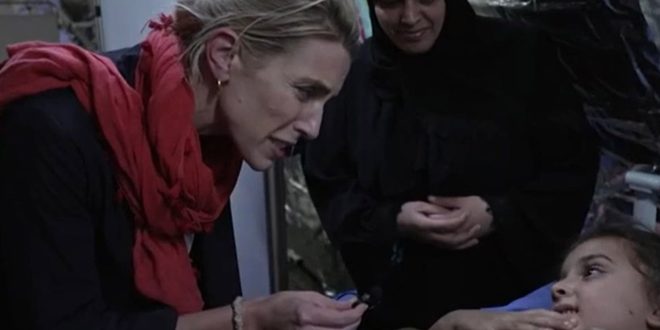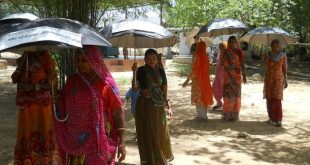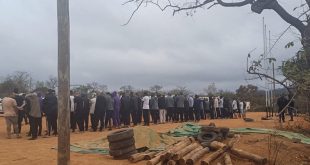On December 14, I came across a report on the CNN website titled “Watch Clarissa Ward report from inside Gaza for the first time since war began”, which grabbed my attention, as good headlines usually do. The subheading further heightened my interest – “CNN’s Clarissa Ward witnessed the horror and humanitarian crisis unfolding in Gaza during a visit to a field hospital in Rafah operated by the United Arab Emirates”.
American journalists had not reported from within Gaza – except a few embedded with Israeli troops – because Israel, as the occupying power in control of the Gaza Strip’s borders, has been denying access to foreign journalists and putting pressure on Egypt to do so as well. So I was intrigued by how Ward had managed to gain access and saw her report as a chance to learn if such on-the-spot coverage would compensate for the broadly awful Western mainstream media coverage of the previous nine weeks.
Over the previous two months, I had observed heavily pro-Israeli, distorted, and incomplete coverage, especially on American television.
I saw most news presenters and show hosts expressing strong bias for Israel, in their words, tone of voice, and editorial choices. The predominance of military analyses by retired US senior officers was equally slanted towards Israel and against Hamas.
The flood of deeply human, personalised, warm, and emotional coverage of Israeli hostages and casualties contrasted with much shallower and fewer reports on the Palestinian victims and prisoners.
So I wondered, would the report from a field hospital in Gaza be better, more balanced, more human? So I clicked on the CNN story link to discover how it was reported from inside Gaza amid the mass murder and human suffering. What follows are a few observations of the strengths and weaknesses of the report. It is important to point them out as an example of the practices that plague the coverage of the Gaza war by most US media outlets.
The report’s strength is that CNN and Ward and her team made the effort to enter Gaza, see its human and material conditions for themselves, and share with the world the images, words, and emotions of a handful of Gaza Palestinians. I salute and thank them, and hope they prompt other journalists to enter Gaza by any possible safe means.
The report also exposes the viewers to the range of human suffering, fear, and helplessness that now defines Gaza. It offers snippets of the stories of a number of casualties, including young children and one orphaned toddler.
The video also captures the moment Israel bombs a location near the hospital; it demonstrates the frightening sensation of hearing and feeling the impact of a shell or bomb that Palestinians in Gaza experience on an hourly basis.
Ward maximises the powerful combination of images, quotes from people she interviews, and her own descriptions, which television at its best can do so well. She beautifully allows the viewer to feel what any visitor to the hospital would experience when she says that she feels “in every bed another gut punch”, as I did when I watched her report. She rightly calls Gaza’s mass suffering and non-stop death “one of the great horrors of modern warfare” and “a window onto hell”.
But elsewhere the report falls short of journalism’s responsibility to give audiences a reasonably complete picture of the situation on the ground in Gaza. Here are a few examples of how an extra sentence, phrase, or just a few words more would have let viewers grasp the full context of these hospitalised young Palestinians’ lives, amid the wider conflict’s causes, casualties, and participants.
- Ward only mentions once, at the start, Israel’s more than 22,000 military strikes and their “intensity and ferocity”. But she fails to say that Israeli bombardment has been so indiscriminate and deadly that legal scholars consider what is happening in Gaza a genocide and there are several major legal cases in the US and Europe to stop it.
- The report says that most patients are women and children, who also account for two of every three deaths. But it does not refer to the fact that Israel’s bombardment has resulted in more than 80,000 dead, injured and missing Palestinians, most of whom are civilians killed at home, in hospitals or United Nations-run schools turned into shelters.
- The report mentions that the UAE hospital is taking patients from other medical facilities, which are overcrowded, but does not say why that is – because Israel has systematically bombed and raided most of Gaza’s hospitals to the point that they are out of service. It also makes no mention of the hundreds of medical workers Israel has killed, which has resulted in severe medical staff shortages.
- The report points to the improvised tourniquet on one injured man rushed into the hospital, but it does not reveal that this is due to Israel blocking the delivery of life-saving and even basic medical supplies.
- All the suffering humans who Ward interviews – with their amputated limbs, killed family members, broken bones, and disfigured faces – are mostly presented in passive, almost abstract, contexts that do not capture their full humanity or the full nature of the conflict. Consequently, most of the Palestinians we meet in the story seem like one-dimensional, caricature-like figures, expressing only fear, misery, and worry. We the audience mostly feel sorry for the Palestinians, but we do not really know them, because no other emotions beyond pity link us to them.
- We are told that one of the patients – 20-year-old Lama, who lost her leg – was studying to be an engineer. But we are not informed that Israel has not only broken her body but her dreams, having devastated Gaza’s universities, making it impossible for Gaza’s youth to pursue higher education in the years ahead.
- The report makes clear that Lama and her family fled their home upon Israel’s orders, but then were bombed in the home where they sought refuge. But we are not told that 80 percent of Gaza’s 2.3 million population have been displaced and are living in appalling conditions, made that much worse by Israel’s full blockade that has cut off food, electricity, water, and medicine.
- The report discusses Gaza in the context of other conflicts in Europe and the Middle East, but does not mention this as the latest episode of Israel’s 75-year-long and ongoing ethnic cleansing, colonisation, and occupation of Palestinians. It does not refer to the fact that the majority of Gaza residents are refugees or descendants of refugees who were forced to flee their homes by Jewish militias in 1948 to avoid being killed.
- While the report mentions that Israel and Egypt have made access to Gaza “next to impossible”, it appears to indicate that this is so because of the danger from Israeli bombardment. This justification is rather bizarre given the fact that Western journalists have been all over the front lines in the war in Ukraine, where they face Russian bombardment. The report avoids saying that foreign journalists are barred from Gaza because Israel wants to control the narrative of the war.
I do not personally know Clarissa Ward, but I have known many CNN correspondents since the channel’s earliest days, and I know they are sincere professionals who aim to do quality journalism. So my comments are not directed at the correspondent or CNN as a whole, but rather seek to highlight the weaknesses of such reports that mirror much of the US’s flawed coverage of Israel’s assault on Gaza.
I raise the issue of poor media coverage of our region because in the United States, United Kingdom, and other Western countries, I’ve seen the damage it has caused by promoting Israeli and Western governments’ views above all others.
Since the media is the public’s main source of information on the Middle East, biased reporting over many decades has created a misinformed citizenry. This has perpetuated government support for Israel’s colonial apartheid system, which now wants to expel into the Sinai Peninsula more Palestinians from Gaza. This in turn allows Israel to resist any serious peacemaking efforts and refuse to comply with international legal norms. The result is the chronic and ever more gruesome warfare that we witness these days.
Our common struggle to create a world of justice and peace goes on. We in the journalism world should step up quickly and forcefully to play a constructive role by using the tools we know so well to communicate truths across frontiers.
The views expressed in this article are the author’s own and do not necessarily reflect Al Jazeera’s editorial stance.
 Top Naija News – Nigeria News, Nigerian News & Top Stories Top Naija News – Nigerian Newspapers, Nigerian News. topnaijanews is a daily Nigerian newspaper covering Latest News, Breaking News, Entertainment, Sports, Lifestyle and Politics.
Top Naija News – Nigeria News, Nigerian News & Top Stories Top Naija News – Nigerian Newspapers, Nigerian News. topnaijanews is a daily Nigerian newspaper covering Latest News, Breaking News, Entertainment, Sports, Lifestyle and Politics.




